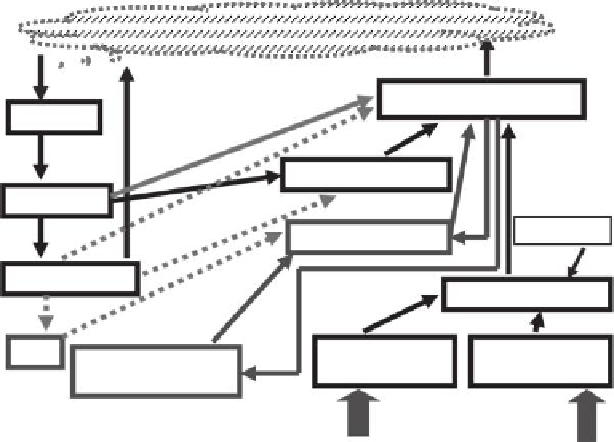Environmental Engineering Reference
In-Depth Information
of traditional farming practiced for more than a few thousand years, until four decades
back (1950s) in India and a hundred years in the Western industrialized countries.
The water that evaporates from various sources, including the oceans, condenses to form
clouds and precipitates as rain. Rain is the essential and eternal requirement for any farm-
ing to take place. This rainwater collects in lakes and ponds and recharges the groundwater.
This water was drawn (initially by sustainable means of animal and human power) during
the nonrainy seasons for farming. It is important to note that the water table in most places
around India was never lower than 10 m. In places around Bangalore (Karnataka, India), it
was accessible within a few meters. Another point to note is the fact that the fertilizers used
were biofertilizers (derived from abundant crop biodiversity) and not chemical/petroleum-
derived fertilizers, simply because the latter were not available. The lake silt was also har-
vested annually to increase the water-storage capacity and also to fertilize the farms. This
traditional sustainable close-loop system was altered to adopt the
Green Revolution
, which
extensively relied on limited high-yield crops and extensive use of chemical fertilizer. Use
of chemical fertilizers vitiates the soil's natural ability to generate and retain nutrients, and
consequently compromised the closed-loop system (see Figure 15.6).
The use of chemical fertilizers resulted in two consequences: irst, it opened up the
closed-loop traditional cycle and, second, the desilting of lakes stopped, and consequently
the recharging of the underground water diminished as the lakes silted up. Further, the
phosphates and nitrates in chemical-based fertilizers are extensively mined and relying
on petroleum derivatives (natural gas and other hydrocarbons). The required raw materi-
als are mined from various places across the world, and these are now overexploited and
running out (Gilbert 2009). They are running out simply because mining is an open-loop
cycle. With their dependence on petroleum derivatives, the cost of chemical fertilizers also
keeps increasing as that of the petroleum products. To insulate the farmer from steep
fertilizer costs, the government provided subsidies, which today in India have reached
Farming
Clouds
Well water (3-10 m)
Rain
Subsidies
Biofertilizer
Lakes/ponds
Chemical fertilizer
Mining
(phosphates)
Hydrocarbons
(nitrates...)
Silt
Animal feed/
human feed
Less human effort but
unsustainable
FIGURE 15.6
Chemical fertilizer-based green revolution in India (open system).

